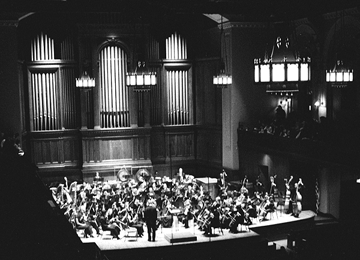








Oberlin's Baroque Ensemble with guest soprano Christine Brandes continued this year's exciting recital series with a magnificent performance of some gems from the Baroque repertory in Kulas Recital hall.
The ensemble and Brandes's commendable stage presence and sound prove the artists to be masters of both performance and practice of the period.
The program started with two selections by Handel. Brandes gave each of the pieces its own meaning and feeling. She sang movingly, with passion and joy. The pieces came alive with the text. Both the flute player and the violin player, Michael Lynn and Marilyn McDonald, respectively, added much to Handel's musical texture with their articulate playing.
Trio Sonata in D minor for recorder, violin and basso continuo by Telemann was next on the program. Although this piece was well played, the harmonies were predictable and at times even became a bit tedious to listen to. The musical aspect of this piece came through nicely but the interest level never reached beyond the feeling of background music.

Three arias by Bach followed, bringing Brandes again to the spotlight. She made beautiful musical phrases with the sometimes harsh German text. Perhaps the most spectacular of these arias was Jesus soll mein ersts Wort from Cantata 171. With her expressive singing, the audience actually became a part of the performance. She painted the meaning of the text with her voice, facial expressions and hand gestures. One could not help feeling disappointed when this fine example of composition and performance ended.
After intermission, Sonnerie de Sainte Geneviève du Mont by Marin Marais took center stage. This piece for violin as basso continuo is based on only a couple of notes: those heard on the church bells at Sainte Geneviève du Mont. This work proved to be entertaining as the composer continually found new ways to work with the bell tones in his piece.
By far the best was saved for last. Orphée from Cantates Françaises by Louis-Nicolas Clérambault employed all of the ensemble in some form or another by having each member, in addition to the constantly singing Brandes, play alternating movements. Using the mythical Orpheus, Clérambault constructed his own history and set it to the most wonderful music imaginable.
The interpretation was highly inventive, colorful and expressive. The ensemble brought out the many hues of musical style, phrasing and balance with all of its playing that are so often forgotten and misunderstood by some ensembles. Brandes sang with her heart not just in this last piece but in everything that the fortunate audience heard that night.
Music for the masses: Finney filled up with parents for the orchestra concert. (Photo by Christina Rudden)

Copyright © 1996, The Oberlin Review.
Volume 125, Number 6; October 11, 1996
Contact Review webmaster with suggestions or comments at ocreview@www.oberlin.edu.
Contact Review editorial staff at oreview@oberlin.edu.